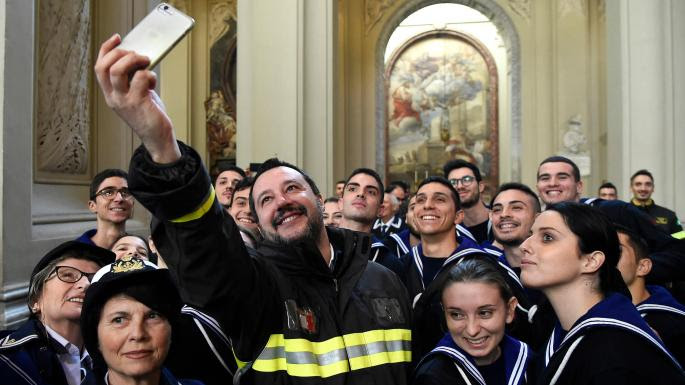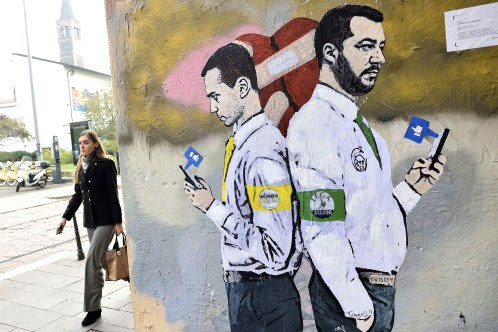WORLD AT FIVE
How Matteo Salvini conquered Rome
Italy’s leading populist has won hearts, minds and social media followers in a city once reviled by his party. Tom Kington reports

Share
Armies from the north have made a habit of fighting their way into Rome through the centuries, but when he enters the city tomorrow, Matteo Salvini is likely to be met by rapturous cheers rather than raised swords.
The deputy prime minister of Italy is betting that 100,000 supporters will welcome him at a huge rally set to confirm his grip on the country’s politics and mark the transformation of his party from a former separatist group, the Northern League, into a renamed national force, the League.
Taking no chances, he has booked 200 coaches and three trains to bring supporters to Rome’s Piazza del Popolo. There, the Italian flag will be waved at the League’s first major rally in the capital. Headlined “From Words to Deeds”, the occasion will see Mr Salvini take a bow for pushing through a law last month to crack down on migration, which has helped his support grow from 17 per cent to over 30 per cent since he took office in June. The boost has sent him surging past his Five Star coalition partner in the polls.

The crowd is sure to roar approval at Mr Salvini’s plans to boost pensions and cut taxes, and will boo the EU commissioners mulling sanctions against Italy because of the deficit that those plans will generate. There will be barbs aimed at his favourite foe, President Macron of France, who opposed Mr Salvini’s closure of Italian ports to migrant rescue ships.
“I want to build a more democratic Europe where the parliament has more power and the Commission has less, where the union does a few things, but does them well,” Mr Salvini told The Times. “If a great country like the UK has voted to abandon Europe, it shows something doesn’t work.”
A former communist with middle class origins, Mr Salvini, from Milan, prefers to go tie-less and speaks with a pronounced Lombardy accent. He can keep an audience rapt thanks to the oratorial skills he honed as a DJ at the party’s radio station.
Analysts are racing to understand how Mr Salvini went from being the coalition’s junior partner to taking centre stage, to the point where his followers claim his social media feed is more important than television news.
Part of the answer is Facebook. With over 900 posts since January — a blend of migrant crime news, insults aimed at EU officials and the obsessive reposting of brickbats he receives from his critics — Mr Salvini has built his following to 3.4 million, with 28 million interactions from “likes” and emojis to comments. His post on Friday morning celebrating a decision by the charity Medecins Sans Frontieres to end its rescue operation off the Libyan coast drew more than 20,000 likes, heart-shaped and laughing emojis.
His breakneck schedule is relayed through tweets, posts and live video, turning his life into a one-man reality show. Last Tuesday, between tweeting about migrant arrests, posting a photo of his lunch, posing for selfies at a Mass and doing a TV interview, he spoke via Facebook live video for 80 minutes.
Data collected by the Eikon Strategic Consulting Group in Rome shows the number of interactions wth Mr Salvini’s posts this year was matched by Luigi Di Maio, the leader of Five Star, but only until the end of October when Mr Salvini took a commanding lead.
“Luigi Di Maio has tried to be a man of government and has left behind Five Star’s original emotional appeal, just as Salvini’s social media team decided to step up the emotion and simplify the message about defending Italy from Brussels and migrants,” said Enrico Pozzi, CEO of the group.
Mr Salvini’s followers have used angry face emojis 602,000 times this year to respond to his posts, while Mr Di Maio’s followers have used the symbol 130,000 times. Much of that anger has been directed at Laura Boldrini, the former Italian parliament speaker who has been slammed by Mr Salvini after she defended migrant rights.
“Salvini has linked my name to migrant crimes for five years on social media, letting loose a wave of hatred against me which is why my daughter and I have been receiving death and rape threats,” she said. “He is using social media as a weapon to intimidate and silence opponents.”
Mr Salvini targeted an unlikely new foe, Pamela Anderson, yesterday after she tweeted that Italy risked returning to fascism. Posting a photo of the actress next to details of the rally in Rome, he wrote: “She won’t be there”.
#PamelaAnderson: “Salvini non è la soluzione, le tendenze attuali in Italia mi ricordano gli anni ’30”.
Ahimè, con dolore, da affezionato spettatore e fan di “#Baywatch“, lei questo sabato a Roma non ci sarà.
#primagliitaliani #dalleparoleaifatti
Mr Salvini denied that his posts were driving divisions in Italian society. His social media blitz was “not a political calculation,” he told The Times, “but because I want to be part of a community.”
And it is not all migrants and anger. Mr Salvini also asks his followers to send in cute pet pictures, and this week he posted a photo of a mascarpone and Nutella cake with the caption “Should I?” — receiving 2,100 comments in response.
In a live video earlier this week he explained what set him apart from other politicians. “I like to go shopping, I like to have an ice cream with my children, I like to take taxis, buses, the underground, and I like to put a hat on and take evening strolls, go for a run, and take a plane or train like everyone else.” He added: “I am one of you.”



